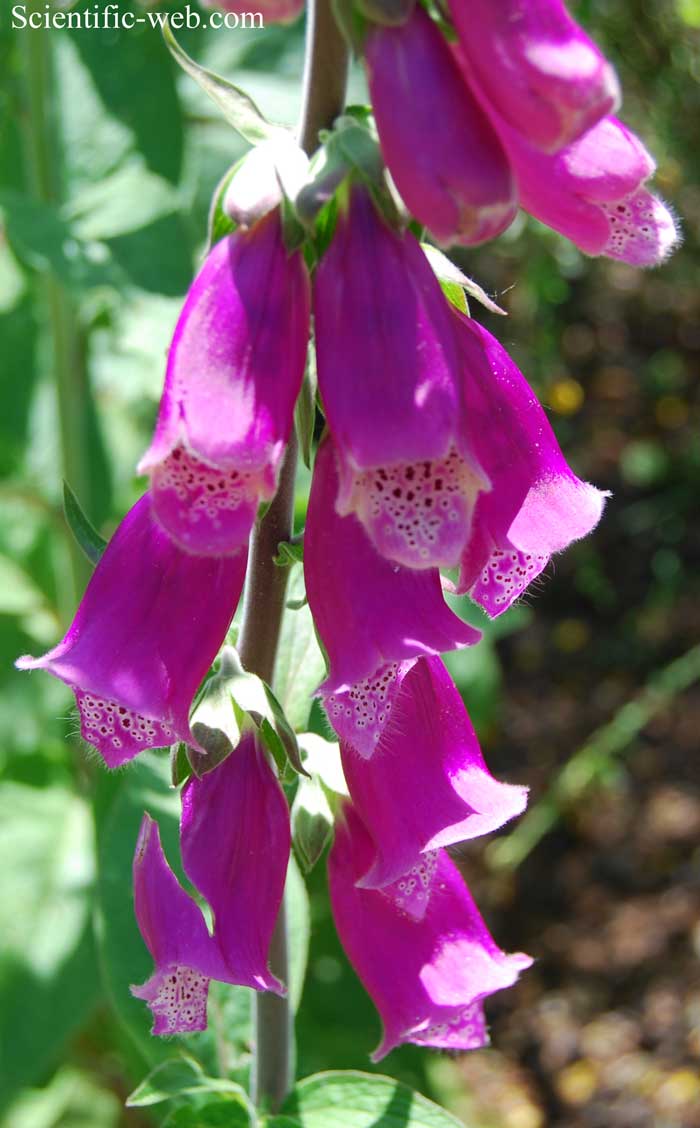Digitalis purpurea, Photo: Michael Lahanas Cladus: Eukaryota Name Digitalis purpurea L. References * Species Plantarum 2:621. 1753 Vernacular names
--------- Digitalis purpurea (Common Foxglove, Purple Foxglove or Lady's Glove), is a flowering plant in the family Plantaginaceae (formerly treated in the family Scrophulariaceae), native to most of Europe.
It is a herbaceous biennial plant. The leaves are spirally arranged, simple, 10-35 cm long and 5-12 cm broad, grey-green, downy, and with a finely toothed margin; they form a tight rosette at ground level in the first year.
The fruit is a capsule which splits open at maturity to release the numerous tiny (0.1-0.2 mm) seeds. Subspecies There are three subspecies: * Digitalis purpurea subsp. purpurea – most of Europe
Due to the presence of the cardiac glycoside digitoxin, the leaves, flowers and seeds of this plant are all poisonous to humans and some animals and can be fatal if eaten. Extracted from the leaves, this same compound, whose clinical use was pioneered as digitalis by William Withering, is used as a medication for heart failure. He recognized that it "reduced dropsy", increased urine flow and had a powerful effect on the heart. Unlike the purified pharmacological forms, extracts of this plant didn't frequently cause intoxication because they induced nausea and vomiting within minutes of ingestion, preventing the patient from consuming more. The main toxins in Digitalis are the two chemically similar cardiac glycosides: digitoxin and digoxin. Like other cardiac glycosides, the Digitalis toxins exert their effects by inhibiting the ATPase activity of a complex of transmembrane proteins that form the sodium potassium ATPase pump, (Na+/K+-ATPase). Inhibition of the Na+/K+-ATPase in turn causes a rise not only in intracellular Na+, but also in calcium, which in turn results in increased force of myocardial muscle contractions. In other words, at precisely the right dosage, Digitalis toxin can cause the heart to beat more strongly. However, digitoxin, digoxin and several other cardiac glycosides, such as ouabain, are known to have steep dose-response curves, i.e. minute increases in the dosage of these drugs can make the difference between an ineffective dose and a fatal one. Symptoms of Digitalis poisoning include a low pulse rate, nausea, vomiting, and uncoordinated contractions of different parts of the heart leading to cardiac arrest and finally death. Uses The plant is sometimes grown in gardens. In suitable conditions it generally seeds itself in partial shade, and can become a minor weed. The pollen contains up to 80% digitalis and this pollen can be found on nieghboring plants stamens when they are in bloom. This effect can cause accidental digitalis exposure if the exposed stamens of other plants are consumed in any way by humans. During the peak pollen production, in some areas the pollen floats heavily in the air and will stick to exposed surfaces. Selected forms, either for colour or for dwarf habit, are sold as pot plants. Use in Molecular Biology: Digoxigenin Digoxigenin (DIG) is a steroid found exclusively in the flowers and leaves of the plants Digitalis purpurea and Digitalis lanata. It is used as a molecular probe to detect DNA or RNA. It can easily be attached to nucleotides by chemical modifications. DIG molecules are often linked to uridine nucleotides; DIG labeled uridine (DIG-U) can then be incorporated into RNA probes via in vitro transcription. Once hybridisation occurs in situ, RNA probes with the incorporated DIG-U can be detected with anti-DIG antibodies that are conjugated to alkaline phosphatase. To reveal the hybridised transcripts, alkaline phosphatase can be reacted with a chromogen to produce a colour precipitate.
* Flora Europaea: Digitalis purpurea Source: Wikispecies, Wikipedia: All text is available under the terms of the GNU Free Documentation License |
|


